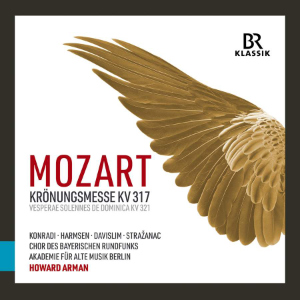
Wolfgang Amadeus Mozart (1756-1791)
Missa, K. 317 ‘Coronation Mass’ (1779)
‘Church Sonata’, K. 329 (1779)
Alma Dei creatoris, K. 277 (1777)
Vesperae solennes de Dominica, K. 321 (1779)
Katharina Konradi (soprano)
Sophie Harmsen (mezzo-soprano)
Steve Davislim (tenor)
Krešimir Stražanac (bass)
Nikolaus Pfannkuch (cantor of the antiphons)
Raphael Alpermann organ)
Chor des Bayerischen Rundfunks
Akademie für Alte Musik Berlin/Howard Arman
rec. 19-21 May 2022, Herkulessaal der Residenz, Munich, Germany
BR Klassik 900530 [60]
Following a disastrous journey from September 1777 that took Wolfgang Amadeus Mozart and his mother through Munich and Mannheim to Paris, the 23-year-old composer returned, dejected, to Salzburg in January 1779. Not only had he not obtained stable employment, he was heartbroken from his unrequited love for Aloysia Weber and devastated over his mother’s death in Paris on 3 July 1778. Mozart resumed his position as organist in Archbishop Hieronymus von Colloredo’s court and produced a series of liturgical works that count among the greatest in the genre.
Completed in time for performance around Easter 1779 in Salzburg’s Cathedral, the Missa in C Major, K. 317, usually called the ‘Coronation Mass’, is Mozart’s most popular completed mass setting (the Great Mass in C minor, K. 427, and the Requiem in D minor, K. 626, are unfinished). Festivities for Emperor Leopold II’s coronation as King of Bohemia at Prague in 1791 included a performance of this mass directed by Antonio Salieri (hence the title ‘Coronation Mass’). The work is scored for strings (without violas), two oboes, two horns, two trumpets, three trombones, timpani, basso continuo (cello, bassoon, contrabass), organ, soloists (soprano, alto, tenor, bass), and choir.
On the present recording, conductor Howard Arman has interpolated within the ‘Coronation Mass’ religious works that Mozart composed contemporaneously. Whereas sections of masses are played in direct succession on audio recordings and in concerts, they were interspersed with other musical pieces, readings from the Bible, and sermons in their original liturgical settings. These insertions between individual parts of the Missa do not disrupt its coherence, but situate it historically without attempting to reconstruct a specific occasion. Arman adds musical context to ‘period’ performance practice, which tends to focus on instruments and voice types.
Arman has placed the ‘Church Sonata’ for orchestra (two violins, cello, bass, two oboes, two horns, two trumpets, and timpani) with obligato organ in C Major, K. 329/317a (1779) between the Gloria and Credo of the ‘Coronation Mass’. Alma Dei creatoris in F Major K. 277/272a, situated between the Credo and Sanctus, is a homophonic Marian motet. Since the autograph score is missing, and the copy with Mozart’s handwritten entries in the Salzburg Cathedral Archive is undated, stylistic similarities with Sancta Maria, mater Dei K. 273 and the Missa brevis K. 275/272b suggest that it was written in the autumn of 1777. Mozart composed Vesperae solennes de Dominica in C Major, K. 321, the final composition on this disc, in 1779. This work consists of six movements (Dixit Dominus in C, Confitebor in E minor, Beatus vir in B-flat, Laudate pueri in F, Laudate Dominum in A, Magnificat in C) and is scored for soloists, chorus, orchestra, and organ.
This release is a valuable contribution to the discography and fares well in comparison with other historically-informed recordings, especially those of the ‘Coronation Mass’ directed by Christopher Hogwood (1993), Trevor Pinnock (1994), and Ton Koopman (1995). Katharina Konradi’s refulgent soprano solos in the Kyrieand the Agnus Dei equal the finest on record. Mozart accorded the soprano more passages than the rest of the vocal quartet (mezzo-soprano Sophie Harmsen, tenor Steve Davislim, bass Krešimir Stražanac), who deliver precision and emotional engagement in their brief solos and when they blend, for example in the Benedictus. The Chor des Bayerischen Rundfunks conveys a sense of religious devotion, which suits this music, with restrained entries to the Kyrie and Gloria and judicious dynamics throughout. Under Arman’s direction, the Akademie für Alte Musik Berlin exudes panache, particularly in the Gloria and the ‘Church Sonata’, and imparts subtlety, especially in the Agnus Dei.
BR-Klassik’s live recording captures the acoustic of the Herkulessaal without sacrificing clarity or detail. It sounds similar to being seated in the middle of the hall where there is an ideal balance of the musical forces. The CD is packaged in a plastic jewel case with a cardboard slipcase and a booklet containing two scholarly essays by Alexander Heinzel and Jörg Handstein in German with English translations. The only demerit is that the sung texts have not been printed along with the commentary. It is unpleasant to download libretti and read them on a screen. The vocal texts could be included without increasing the size of the booklet by eliminating the artist biographies and photos, which are not integral to the listening experience.
Daniel Floyd
Help us financially by purchasing from





















